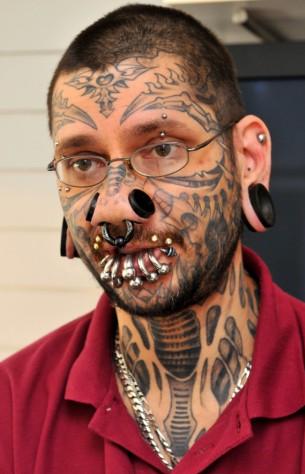They will tell the educated onlooker exactly what the tattooed has done in their own criminal career; if they have been in prison, betrayed, lied, stolen or murdered. They speak of the wearer’s position within the criminal hierarchy, the people to whom they have loyalty, even their sexual preference.
 Russian Mafia
Russian MafiaTo bear the truth with your tattoos is vital as a member of the Russian underworld; if you are exposed as possessing fake tattoos or tattoos that lie about you, the chances are high that the consequences will be severe. If you lose your rank or change loyalties, there is a decidedly painful way to show it; you’ll have to burn off your old tattoos with magnesium powder and tight bandages, quite literally burning away your skin and 'old truths' to make way for new ones.
A newly introduced gang member is thought to commence their career with a tattoo on their chest, often of a rose. Just as the Yakuza are known to do, the higher level Russian mafiosos will keep a trained, modern, hygienically aware tattoo artist in their employ for all ink jobs that need doing; lower down the scale, in prisons for example, it’s grislier. Ink is supposedly made from shoe heels burnt to soot and urine, needle machines composed of guitar strings and electric razors. Typically tattoos are one-coloured, simple and blue-ish in tone. They are mostly hidden away by every-day wear, being situated on and around the torso.
The meanings and precise symbolism of these tattoos is of course slightly misty and obscure to anybody outside the gang culture, but a few can be discerned. A cathedral with five domes can symbolize five years of imprisonment, for example. Stars, very particularly stylized on the knees, symbolize a man who has never had to kneel before anybody; stars found on the chest however signify a ‘career criminal.’
Criminal organization members who break the gang honour code, fail to pay debts, snitch, cheat or any litany of other things can be forcibly tattooed, too; this obviously happens most often in prisons, and the tattoos applied are generally lewd images or derogatory words.
As Lambert’s millennium film, Mark of Cain, notes, criminal tattoos in Russia are fast fading as a practice, perhaps in relation to the increasing ‘first world westernization’ phenomenon spreading across the globe – in this monopolizing culture, tattoos are best appropriated for fun, personal significance and aesthetics, not shady criminal signifiers. It did, however, inspire Cronenberg in recent 2007 to make his own film revolving around the concept of Russian Mafiosos and their tattoo culture, Eastern Promises.
The story goes that lead man Mortensen, a notorious method actor, briefly took to the habit of wearing his character’s ‘tattoos’ off set until he took himself to a Russian restaurant one evening and the people who were dining near him descended into stony silence upon sighting his decorated hands. Even in contemporary culture, a Russian will still recognize mafia ink and the potentially dangerous character wearing it. As Mortensen said, for criminal underworld employees, tattoos are their ‘calling card,’ an etched history on their body.

 Russian Mafia
Russian Mafia Russian Mafia
Russian Mafia Russian Mafia
Russian Mafia
No comments:
Post a Comment